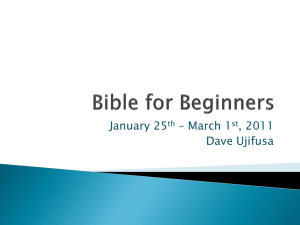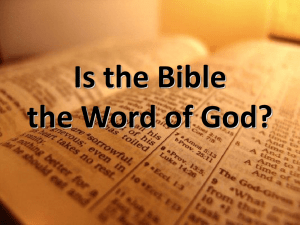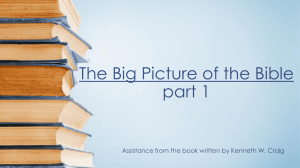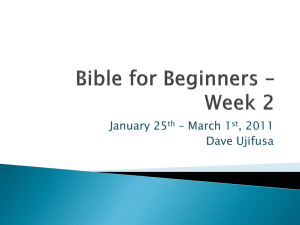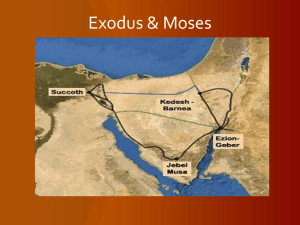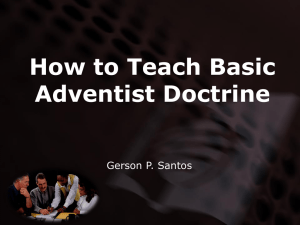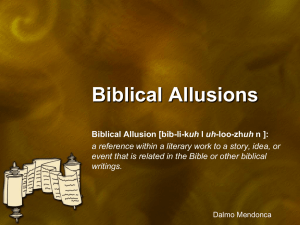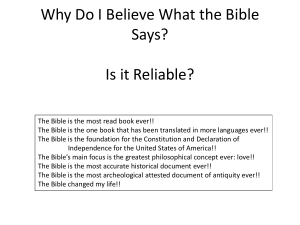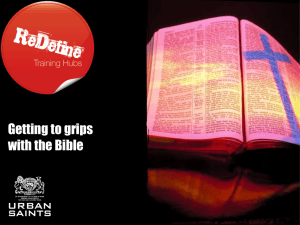Chapter One
advertisement
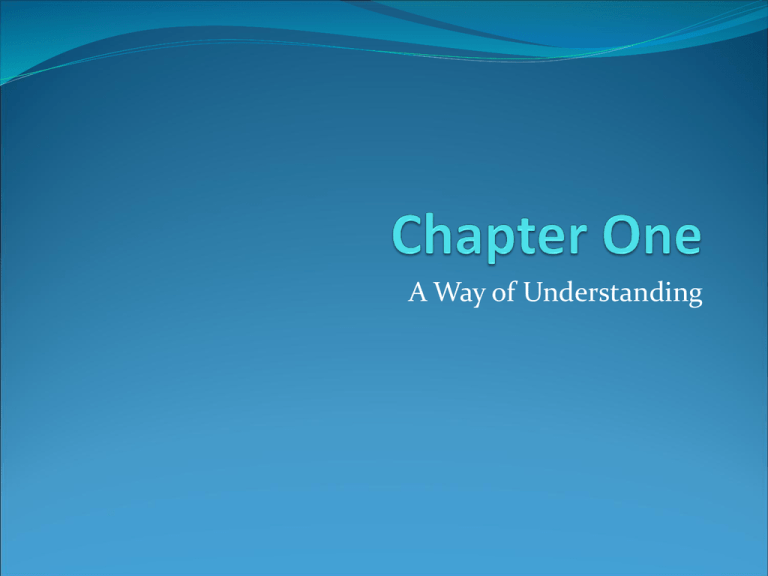
A Way of Understanding Chapter One Outline Chapter 1 Outline http://www.spokentext.net/members/JeanieCrain/Ch._1_PP_Audio.mp3 Preliminary Considerations Definitions Form Translations Reading the Bible as Literature Appeal and Readership A Literary Approach Intertextuality, Allusion, and Typology Prophecy Macro-Plots Language Meta-narrative Monomythic and Universal Impact on Literature Experiential Truth Approaches Taken in Textbooks for Teaching the Bible as Literature Traditions in Biblical Interpretation Culture and Religion in Ancient Israel and the Jewish World View Preliminary Considerations The “Bible” includes the authoritative Jewish and Christian biblical canons and consists not of original manuscripts, but “copies of copies of copies” of texts. David Dewey, A User’s Guide to Bible Translations: Making the Most of Different Versions (Downer Grove, IL: InterVarsity Press, 2004), 204, provides a useful overview of versions of the Bible. The Roman Catholic and Orthodox churches include the deuterocanonical or apocryphal books of the Greek Septaugint (LXX). Definitions, Cont. The Jewish Bible refers to the texts that correspond to the Christian Old Testament, in a different order, as Tanakh, a collection including the Torah (Law), Nevi’im (Prophets), and Kethuvim (Writings). Scholars often use “The Hebrew Bible” to avoid taking religious sides in debates about the two covenants, but this term properly designates texts originally written in the Hebrew language, excluding the deuterocanonical or apocryphal books, or it refers, more broadly, to the tradition that preserved these texts to the age of printing Translated, the Hebrew Bible is known familiarly as the “Jewish Bible.” Marc Zvi Brettler, How to Read the Bible (Philadelphia: The Jewish Publication Society, 2005), 1-12, makes the point that academic scholars “generally prefer not to take sides in the debate as to which covenant with God is in force.” Definitions, Cont. This text uses “Bible” to refer to the commonly anthologized thirty-nine books of the Old Testament and the twenty-seven books of the New Testament within the broader frame of different traditions without, hopefully, giving credence to the unfortunate connotations that often accompany these names. “Old” and “New” have not been used to suggest that the Christian faith has superseded (supersessionism), or is superior to, Judaism; nor is there the suggestion that the New Testament merely reinterprets, or distorts, the older tradition. Patrick Alexander, et al., eds., The SBL Handbook of Style: For Ancient Near Eastern Biblical and Early Christian Studies ( Peabody, MA :Hendrickson Publishers, Inc.,1999), 17, suggest that authors keep “aware of the connotations of alternative expressions such as… Hebrew Bible [and] Old Testament” and use them without prescribing the use of either. Walter Brueggemann, An Introduction to the Old Testament (Louisville, KY: John Knox Press, 2003) 2 says, the church has always found the two collections close and intimate and that the Christian faith “is both continuous and discontinuous from it [Old Testament], and that the matter admits of no easy articulation.” Frank McConnell, ed. The Bible and the Narrative Tradition (New York: Oxford University Press, 1991). Questia. (21 May 2009) http://www.questia.com/PM.qst?a=o&d+6305566 6 quotes Frank Kermodes’s The Genesis of Secrecy to say “that only once in the history of culture has a book had its entire meaning altered simply by renaming it, ...to be specific, the ‘Old Testament.’” Definitions, Cont. Christians, for example, typically read the Old Testament toward the New Testament while Jewish people tend to read the same texts in the direction of the Talmud, a post-biblical, substantive body of teachings. Boccaccini, 4, understands Christian and Jewish traditions as advancing the theological model of “one Judaism” that has impeded critical scholarship. He says study requires looking at Christian and Jewish sources in relation to each other. Definitions, Cont. In Hebrew, the personal and proper divine name, considered too sacred to pronounce, is represented by four consonants (YHWH, known as the Tetragrammaton) transliterated as Yahweh (LORD) and appearing about seven thousand times in the Jewish Bible. Synonyms include Yahwe, Yahveh, YHVH, Yahve, Wahvey, Jahvey, Jahweh, Jehovah, and JHVH. A traditional Hebrew reading translates YHWH as Adonai, my Lord, for the sake of reverence (third century BCE, used about 300 times in the Hebrew Bible). Elohim, another reference, denotes “gods” or “divine powers” with emphasis on the plural. The plural form characterizes much of the Hebrew Bible and appears over two thousand times. Eastern languages used El, the singular form, to refer to God (shows up about two hundred times in the Hebrew Bible). Jehovah refers to the Latin rendition of the Tetragrammaton, to which the vowels from Elohim and Adonai were added. This divine name can be traced to 1518 CE. Definitions, Cont. In talking about the origins of the Bible, I refer to historical dates as CE (Common Era) and BCE (Before the Common Era), Common Era meaning the time common to the Judeo-Christian tradition. You may be more familiar with the use of BC (Before Christ) and AD (Anno Domini, in the Year of the Lord). By using BCE and CE, I hope to encourage you to expand your understanding and tolerance for different approaches to the Bible and to acknowledge the general use of these abbreviations in non-Christian contexts. Form Hebrew manuscripts, for example, made no distinction between prose and poetry, no division of sentences, paragraphs, meter, speeches in drama, or even separation into words; in fact, ancient manuscripts made no distinction between lowercase and uppercase letters, used no marks of punctuation, and used no spaces between words, leading to the possibility for multiple interpretations of strings of letters. By the third century BCE, scrolls were divided into sections, larger sections marked off by a new line, and smaller sections delineated by a gap in the text. This practice was continued with the Masoretic text (between the seventh and tenth centuries CE). Form, Cont. Stephen Langton, an archbishop of Canterbury (1223 CE), developed the chapter division that became a model for other texts. Perhaps as early as 200 CE, the Hebrew and Aramaic translations included verse divisions; a Jewish Rabbi Nathan divided the Hebrew Bible into verse (1448 CE), and Robert Estienne (1555) divided the New Testament into verse. Brettler, 29, says chapter divisions first appeared in the Vulgate, thus relatively recently. Translations Every translation of the Bible affects meaning in different ways, with translations generally existing on a continuum that runs from literal to moderately literal (form-based), and from moderately idiomatic to idiomatic (meaning-based). Literal translations retain much of the Hebraic and Greek forms of language, including poetic form; idiomatic translations tend to be meaning-based and to convert original languages into modern day language, sometimes to the extent of liberal paraphrase. For this book, I have used the The New Oxford Annotated (NRSV), a translation that brings together form and meaning, presenting a highly literal translation that goes back to the King James Version authorized in 1611. This translation bases itself upon the critical editions of original texts and subscribes to no particular confessional allegiance. Other versions with which I’ve consulted throughout include The Jewish Study Bible, The New Interpreter’s® Study Bible (particularly useful for its identity and discussion of multiple sources), and the HarperCollins Study Bible. Norton ,401,436, laments the standard (KJV, 1611) that creates a classic “perpetually and inescapably encountered by all of us.” Appeal and Readership We know that people read the Bible for many reasons—religious, moral, historical, and literary—and in different ways—literally, figuratively, or symbolically—and consider it “divinely dictated, revealed, or inspired, or as a human creation.” The religious texts of the Bible have commonly been thought to represent something more than acts of the imagination and something more than “just literature.” Read generally, the Bible has been impacting the lives of people for over two thousand years; many people, in fact, read the Bible “as religion” and “as Scripture,” as a book describing how “to serve God,” and find in it an overriding story of the relationship between God and human beings, the story of creation, the nature, behavior, and destiny of humankind. Each of three major monotheistic religions—Judaism, Christianity, and Islam—find in the Bible a foundational set of texts. Sometimes read as history, and certainly, containing history, the Bible reaches before history into primordial and mythical time, and projects beyond history into a metaphysical and transcendental future. It raises interesting issues about the subjects of art, fiction, and history. Scholars worldwide, using multiple inroads, have read and commented upon the Bible; in fact, the Bible is commonly described as attracting a greater mass of secondary writing than any other collection of literature. Appeal and Readership, Cont. Richard Elliott Friedman ,16, 15, Who Wrote the Bible (HarperSanFrisco: HarperCollinsPublishers,1997) 15 begins his discussion by extolling the impact the Bible has made, making note of religious, moral, literary, and historical approaches, while pointing to the obvious fact that readers of the Bible do not have easily available the traditional approach of asking about the author and the author’s life. Bart D. Ehrman, Lost Christianities: The Battles for Scripture and the Faiths we Never Knew (NY: Oxford University Press, 2003), 249 ,describes the New Testament canon as “the victory of the protoorthodox” and wonders what would have happened if another group had won. Norton, 271, provides an excellent academic discussion of the many tensions that have surrounded reading the Bible, noting that approaching it as a literary work became strong in the eighteenth century. Thomas L. Thompson 104 The Mythic Past: Biblical Archaeology and the Myth of Israel , 1st ed (New York: Basic Books, 1999), 29 ,talks about Israel as playing a role within a morality story. Northrope Frye, Words with Power Being a Second Study of The Bible and Literature (New York: Harcourt Brace Jovanovich, Publishers, 1990) ,xiv-xv, 99 ,says that although the Bible is “written in the literature of myth and metaphor” and may be described as “a work of literature plus,” calling it by a post-biblical term would be “an abuse of language.” James L. Kugel, How to Read the Bible: A Guide to Scripture Then and Now (New York: Free Press, 2007), 685, describes “Scripture [in Judaism]”as the beginning of a manual entitled To Serve God.” Norton ,378, 385, 380, states that Robert Alter’s The Art of Biblical Narrative accommodates belief and engages discussion of what in the Bible is “historicized fiction” and “fictionalized history.” Reading the Bible as Literature Reading the Bible “as literature” invites readers, minimally, to focus on reading and appreciating the books of the Bible as they exist. Introductory literature courses traditionally have focused upon existing texts, paying attention to the acts of reading, understanding, and assessing. They emphasize unity, coherence, and whole-part relationships, looking at a text as having a beginning, middle, and an end. Introductory courses require readers to gain a sense of the “whole” text and to read in this context. Such courses exist to help students acquire some basic tools for reading and understanding individual works; students have been told that literature embodies human experience and that they can learn from reading literature much about themselves, others, and the world itself. They have been encouraged to read with an attitude of curiosity, particularly for diversity, and an open mind, engaging self-criticism and discovering that asking questions may be more important than committing to answers (Table 1.6 www.readingthebibleasliterature.com). They learn that texts have life away from their origin and that meaning becomes inextricably bound to the act of reading. Reading becomes the foundation for analysis, interpretation, and reassembling a text as “a whole.” John B. Gabel, Charles B. Wheeler, and Anthony D. York, eds. The Bible as Literature: An Introduction (New York: Oxford University Press, 1990), 1 ,regard the Bible as a product of the human mind, a collection of writings produced by real people who lived in actual historical times. Norton, 272, 407, says “the book contains almost nothing of what ought to be basic to a literary discussion of the Bible, faults the book as engaging in a “tiptoeing neutrality,” and points out that NKJV has not been “designed to be read as literature, introducing the possibility that the common, religious reader will still prefer sacred text to literature and that publishers provide what sales.” Leland Ryken and Tremper Longman III, “Introduction” to A Complete Literary Guide to the Bible (Grand Rapids, Michigan: Zondervan Publishing House, 1993), 24, quote John Reichert in urging readers to cut through esoteric terms prevalent in approaches to reading the Bible and return to simple procedures. Reading the Bible as Literature F J.P. Fokkelman, Reading Biblical Narrative: An Introductory Guide, tr. Ineke Smit (Louisville, NY: Westminster John Knox Press; originally published as Vertlekunst in de bijbel. Ein handleiding bij literair lezen Netherlands: Uitgeverij Boekencentrum, 1995) ,207-209, recommends grasping the overall shape of a text and in reading from within…the whole has priority over the parts.” Norton 274 explains that keeping the Bible before the learner as a whole may present “too much to grasp” and makes “the fruitful use of the Bible [he has in mind the King James Version], as literature, … almost impossible.” Frye, Words With Power xvi, xvii, 101-102, repeats the point several times that “Coherence is a preliminary intuition or assumption about criticism…, a heuristic assumption…,” remarking that criticism, while different from literature, equally requires creativity and performs the important work of “defining and opening the boundaries of literature.” Frye identifies the mythical and metaphorical also form the primary language of criticism. Kugel, 686, 686, describes a shift in the way readers read the Bible: from learning from the Bible to learning about it. Ryken, “The Bible as Literature: A Brief History” in A Complete Literary Guide, 61-65, remarks that “Most current literary criticism [as opposed to traditional] presupposes an audience whose interest in the Bible is academic rather than religious. This contrasts to Mary Ellen Chase, who called for the Bible as accessible to the common reader. Johnson, 2, 142, describes fresh reading as reading “with the intent of discovering at least something of the thoughtworld and mind of the writer.” Fokkelman, 193, defines reading as active puzzle-solving. David M. Gunn and Dana Noland Fewell, Narrative in the Hebrew Bible (New York: Oxford University Press, 1993),9, point to a way of reading that that finds multivalent and contextual meanings “inescapably bound up with their interpreters.” Frye, Words With Power ,75, explains reading as an act that requires readers to go beyond the piece of literature confronting them, to go beyond the object, and to study as well the act of reading. Johnson, 24-25 ,explains that the act of reading requires at least two levels of meaning: the text that contains meaning, and the reader who understands meaning. Friedman 241notes that we have, in a sense, come a full cycle back to dealing with the Bible as a whole. Intertextuality and Typology Biblical canons evidence purposeful organization through traditions of collection, and published as books, they evidence literary principles at work that hold them together and suggest that they can be read as books. One such principle can be described as the intertextuality of the Bible: its use and reference of other texts to influence meaning. This principle should not be confused with typology, the search for deeper and fuller meanings within texts (especially the Old Testament) in light of God’s work in history. Intertextuality and Typology, Cont. Thompson 31 describes the Bible as “survival literature,” explaining that the Hellenistic period “understood themselves as the ‘children of Israel,…’ a surviving remnant from old Israel, or as a resurrected or reborn Israel. Norton, 393, states “There is, in short, arbitrariness or an act of faith involved in any conception of the Bible as a unity. Donahue, Interpreter’s Bible, 2261, regards knowledge of the Hebrew Scriptures as critical to making New Testament writings intelligible. Mcconnell, Questia, 8, says, "’Intertextuality’ is a phrase much bandied--or shuttlecocked-among critics with a yen for the fashionable these days. Like most such phrases it is not only phonetically ugly but, semantically, virtually null.” Typology Typology, explains the characters and events of the Old Testament in terms of the New. For example, it sees Adam as a type of Christ; it understands the story of Jonah as prefiguring Jesus’ resurrection; it understands the exodus as a type of baptism. In short, it understands the Old Testament and New Testament as a unified story which presents Jesus as a descendant of David and a fulfillment of Davidic covenant. The Gospel writer Matthew introduces Jesus as the new Moses; he sees a correspondence between Moses as the prophet of the Old Covenant (Israel) and Jesus as the prophet, priest, and king of the New Covenant (universal). This form of interpretation, found especially in the early church leaders, lost ground after the Reformation (a sixteenth century religious movement) summoned people back to the Scriptures themselves as a counter to ecclesiastical interpretation. Kugel distinguishes typology from allegory, explaining that typology works on the horizontal level to see people and events of the Old Testament as foreshadowings or types of people in the New Testament; allegory works on the vertical level, moving from the concrete to the abstract. Allusion New Testament writers freely allude to, or consciously echo, other Old Testament texts. Since the Scripture they referenced had no chapter and verse divisions, New Testament writers identified the quote or paraphrase by place, such as Moses at the burning bush (Luke 30.27), by time, such as in the days of Abiathar (Mark 2.26), or by words (Rom. 11.2). The New Testament contains a total of about 283 directs quotes from the Old Testament, and, if including indirect and partial quotes, the number jumps to about one thousand. In some instances, the Greek Septuagint (and writers of the New Testament wrote in Greek) was literally quoted, but quotations were also altered or corrected. Ryken, “The Literary Impulse” 362-365 acknowledges the Bible as “unique” but makes the point that it impacts and affects readers existentially, as does other literature. Allusion, Cont. Formulaic quotation uses introductory formulas such as “saying,” “writing,” “what says the Scripture,” “it is written,” “the Scripture has said,” “that it might be fulfilled,” and God, Moses, or Isaiah “has said.” Composite quotations simply combine two or more quotations taken from one or more sections of the Old Testament. Jewish writers in the first century CE knew large portions of the Hebrew Bible by heart, and a clause, phrase, or a word could point to a wider Old Testament context and ideas; the writers of the New Testament had minds richly filled with Hebrew history and allude to it constantly. Prophecy Much of the Bible consists of prophecy, a biblical genre that, by definition, means to speak before and to reveal the events of the future; prophets were considered spokespersons for God, even when their utterances were to be taken ironically, and they acted as intercessors between God and the people. The New Testament consistently references both the Law and the Prophets in the sense of “speaking before,” foretelling, forth telling, and predicting the future. Critics have argued that prophetic interpretations force upon the past an unintended and largely reconstructed meaning. Christianity counters by arguing that texts carry a deeper or fuller meaning than what the authors themselves perceived or intended, and attribute this to divine inspiration and divine direction. Prophecy, Cont. Thompson, 57, counters the traditional notion of prophets as messengers, understanding them rather to function as catalysts to a hardening of hearts and an ultimate rejection of the torah. Stephen B. Chapman, The Law and the Prophets: A Study in the Old Testament Canon Formation (Deutschland: Mohr Siebeck, 2000), 276, insists that “the initial placement of the Torah in the canon has more to do with ‘story’ rather than ‘status.’” Boccaccini, 2, describes the “so-called Christian fulfillment… [as] estrangement, if not treachery and betrayal.” Macro-Plots Another principle that holds together parts of the Bible can be recognized in its macro-plots, a narrative process whereby several layers of stories function as a single entity. An example of this can be found in Genesis and the accounts of beginnings, the eponymous father Abraham, and the Jacob and Joseph cycles. To illustrate, the book received its name from a Greek translation of the Hebrew world “toledot,” which literally means beginnings. Genesis 2.4 says “These are the generations of the heaven and earth when they were made.” Two genealogical registers (5.1, 10.1) present the descendants of Adam and then the descendants of Noah’s sons followed in 11.10 by the descendants of Shem leading to Abraham. Genesis 25 presents the descendants of Ishmael and Isaac, Abraham’s two sons. Yet another chapter (36) presents the descendants of Esau. Genesis concludes with the Jacob and Joseph cycles, the latter linking directly to Exodus and the descendants of Jacob in Egypt. The narrative presents these genealogies as intertwined and related. All generations lead to Egypt, the wilderness wandering, the possession of Canaan, and the birth of the nation of Israel. Macro-Plots, Cont. Gunn and Fewell 29 suggest a way of reading the Bible that places a large narrative (Genesis-2 Kings) into the context of the larger Hebrew Bible. Marcus J. Borg, Meeting Jesus for the First Time ,123, 133 finds three macro-stories “at the heart of Scripture that shape the Bible as a whole”: the story of Exodus, the story of the exile and return, and the Priestly story. Fokkelman 162 demonstrates how structurally Genesis uses toledoth to organize the book as generations or early history. Imagistic Language Perhaps the strongest unifying principle consists of the imagistic, metaphorical, and symbolic uses of language (discussed as images of relationship in the third chapter) that belong to the creative imagination and to literature in general. Since the Enlightenment (beginning in the seventeenth century), a world view has been favored that emphasizes factuality, the scientifically verifiable or historically reliable facts. The Bible, however, belongs solidly with the religious rather than the secular view: it presents an experiential reality in which the boundaries between self and world, subject and object, between realities (the finite and the infinite), soften to allow an experience of connectedness. Imagistic Language, Cont. Marcus J. Borg and N.T. Wright, The Meaning of Jesus: Two Visions (New York: HarperSanFrancisco, A Division of HarperCollinsPublishers, 1999), 10, describes this view as reducing reality “to the spacetime world of matter and energy, thereby making the notion of God problematic and doubtful.” Borg, The Meaning 61 describes the mystical state as “a sense of descending (or ascending) beyond the ordinary level of the self to a level where one experiences communion or union with God.” Imagistic Language, Cont. First, there’s the notion of journey that underlies its macro-plots: Egypt and bondage, and the Babylonian exile and return.” The journey carries with it the possibility of discovering greater realities. There are the Christological metaphors that point to Jesus as the Word of God, the Son of God, and the Wisdom of God: the “I am” the light, the way, the truth, the life, the vine, the resurrection, the door, the good shepherd. Add to these the symbolic uses of light and darkness, all with ancient, archetypal, and cross-cultural meaning. The “kingdom of God,” important to both the Old and New Testaments, carries several metaphorical meanings, having social overtones of God’s coming kingdom as being one of righteousness, social justice (distributive and egalitarian in contrast to humanly kingdoms of oppression). Simply consider the Lord’s Prayer with its “Thy Kingdom come” (Matthew 6:9-13 and Luke 11:1-4). Birth metaphors abound with hope of this idealized future. And as one final example, note the mythical redemption (and transformation) of human beings from between beginning and ending time presented in the images of motion, sight, and wakefulness. The metaphors of death and resurrection in the New Testament, in fact, express this transformation as a process of decentering (death) and recentering (resurrection). Imagistic Language, Cont. Borg, Meeting Jesus “Images of Jesus,” 119-137. Borg The Meaning of Jesus, 149. Borg, The Meaning, 183. Borg, The Meaning ,74-75. Frye, Words With Power xvi, xvii, 101-102. Marcus Borg and John Dominic Crossan, The First Paul: Reclaiming the Radical Visionary Behind the Church’s Conservative Icon (New York: HarperCollins Publishers, 2009), 21, describe enlightenment “as a transformed way of seeing,” a “moving from darkness to light, from blindness to sight, from sleeping to being awake.” Borg, The Meaning, 260. Meta-narrative The fact remains that the anthologized sixty-six books of the Bible have traditionally been read as one book. As a whole, the Bible reveals a loose chronology and overarching meta-narrative that tells a story about the past and the future, with the New Testament reinterpreting the Old Testament. The Bible has also been regarded as containing four acts: creation and fall, Israel, Jesus, and the Church. Meta-Narrative, Cont. The “Introduction” to the HarperCollins Study Bible ,xxiii, says that “Despite the Bible’s diversity, most readers do feel that as a whole it somehow makes sense.” Alter, Genesis xl counsels that “the biblical conception of a book was clearly far more open-ended than any notion current in our own culture” and readers essentially should bracket the modern sense of “book.” Ryken and Longman III, “Introduction” to A Complete Literary Guide, 35, have gained distinction for taking readers through the various literary forms of the Bible; they describe the Bible as containing narrative unity in a loosely chronological arrangement. N.T. Wright, How Can the Bible be Authoritative?” in Vox Evangelian 21 (1991), 7-32. Bible as Story As story, the Old Testament provides a dramatic account of origins with roots in primeval and mythical time. This ancient story presents a God creating the world and pronouncing it good up until the creation of humankind in his own image: a creation that exercises its own will to determine what is good. The stories that follow present an ongoing struggle with God. The history of Israel, as has often been noted, follows a pattern largely of promise unfulfilled due to human rebellion; in time, Israel falls to the Assyrians; Judah, to the Babylonians, with the Persians, Greeks, and Romans over the horizon. A surviving remnant looks to the future for an anointed one, the Messiah, who will reestablish the Jerusalem that has been destroyed. The pattern repeats: Jerusalem built, Jerusalem destroyed. Bible as Story, Cont. David M. Gunn and Dana Nolan Fewell, Narrative in the Hebrew Bible (NY: Oxford University Press, 1993), 2, distinguish the broader term ‘story” from “narrative” and say that defining narrative in terms of character, plot, and word-play is a preliminary step in the exploration of stories. Thompson, 18, “Being like God, and obedience hardly a divine virtue, nothing less could be expected… “ Thompson, 30, says “We do not have an origin tradition that closes with a sense of belonging… That Israel never came to be.” The Christian Story Christianity tells a similar story and looks to a future in which God’s people will be united in a climatic and heavenly Jerusalem that serves as the counterpart to the earthly Jerusalem. Revelation describes the creation of a new heaven and earth in which God’s presence fully abides with humankind: it achieves this by depicting a marriage in which heaven and earth become one; it then describes the creation of a New Eden, a new Tree of Life, and a New Jerusalem. In this way, the New Testament reinterprets tradition in terms of its own hope for a world that expresses divine will. Monomythic and Universal Reading the Bible as literature also opens doors to discovering what in the Bible belongs to literature generally. One finds, for example, in Jesus and Moses, the monomythic and universal hero types. Monomyth refers to a basic pattern in which a hero begins in the ordinary world but receives a call to enter into an unknown and mysterious world of strange powers and events, where he must faces tasks and trials alone or with assistance. Recognizable features include a miraculous birth, initiation at a young age, withdrawal, trial and quest, descent, resurrection and return, ascension, apotheosis, and atonement. Mythic A mythic approach would describe Christianity as combining several aspects of mythology: the virgin birth (Mary, for some, as goddess and Queen of heaven, thought to be a take-off from Asherah and Ishtar), the dying god; the sacrifice, the hanging on a tree, the meeting of time and eternity, and the resurrection. The Asian god Attis is hung on a tree; the Norse Odin hangs on a tree to learn of the mysteries. Indo-European mythology provides background for understanding the use of triads or the use of threes in the Bible: the goddess as maiden, mother, and crone. Adam and Eve represent the first man and woman, with associations that exist in the mythical, such as the mother goddess. The motif of war in heaven can be found in Babylonian mythology. Mythic, Cont. The water of life and baptism can be found in Mesopotamian myth: the god Enki sends Water of Life to comfort the suffering goddess Ereshkigal. Greek mythology presents Zeus and other sky gods. Like Genesis, the Greek story of creation begins with chaos and void out of which came Gaia (Mother Earth), Eros or Desire, Uranos or sky. When the Gospels describe Jesus as descending to the underworld, the motif has appeared in Greek in Herakles, Orpheus, or Theseus. Death, the antagonist of life, has mythical overtones: the Greek Pandora opens her box, and death comes into the world; the Sumerian Ereshkigal is goddess of the underworld. David Leeming, The Oxford Companion to World Mythology (NY: Oxford University Press, 2005) presents an alphabetized list of mythical characters, including biblical representation. Mythology as Foundational to Science, Philosophy, and History While literalist readings of the Bible may fear the mythological, the fact that myth addresses death, the changing seasons, the passage of the sun and moon, and the origin of the universe and life may provide enhancement and appreciation for the Bible as literature. It should be stated that the Bible has also been approached in yet another way: the Bible as history, this generally contrasted to the Bible as mythology, and this approach leads to a discussion of truth and fiction in the Bible. Actually, mythology predates scientific method and the discipline of logic and may, in fact, provide the foundation for them. Northrop Frye, Words with Power, 5-12, xv, identifies the verbal modes as descriptive (perceptions, facts, experience), logical (concepts, dialectical opposites), rhetoric (persuasion, convention, and ideology), and poetic (metaphorical and mythical), explaining that modern thinking has favored descriptive, logical, and rhetorical modes even though mythology preceded them. Bible’s Impact on Literature Reading the bible as literature provides a way to bridge what has been described as a gulf or a gap of “ignorance” between it and general literature. Robert Alter and Frank Kamode, The Literary Guide to the Bible (Cambridge, MA: The Belknap Press of Harvard University Press, 1987), 2-3, remark that the Bible “is probably the most important single source of all our literature” but that its neglect in secularized times has led to a general ignorance that impoverishes the study of literature itself. Impact, Cont. English literature has been described as having its richest sources in the Bible, the Bible contributing to the language, style, expression, and very tone of literature. Knowing the Bible well aids readers in recognizing titles, stories, characters, allusions, genres, images, and plots in literature generally that have been drawn directly from the Bible. Edgar Whitaker Work D.D., The Bible in English Literature (London and Edinburgh: Fleming H. Revell, Co., 1917), 33, says the Bible has “sharpened and determined the very genius of the English-speaking peoples.” Alter and Kermode, 5, recognize “an urgent need to try to learn how to read the Bible again.” Impact, Cont. Archibald MacLeish’s play J.B.borrowed its characters and story directly from the Old Testament Job. Milton’s Samson Agonistes draws on the character of Samuel. Robert Frost in A Masque of Mercy makes Jonah a character in modern New York. The Bible remains the major source and influence for modern literature: running through all of Western literature. Ryken, “The Literary Influence of the Bible” in A Complete Literary Guide ,473-488, 485, concludes, “Usually the story of biblical influence on literature has resembled the history of Western literature itself.” Imagistic The Bible speaks in images that arise out of bodily experience, appealing to and being shaped by the imagination and the emotions. Images exist first then build into a connected pattern of metaphor, symbol, and archetype, these all contributing to meaning within the universal, shared language of culture. Leland Ryken, How to Read the Bible as Literature …and get more out of it (Grand Rapids, MI: Zondervan™, 1984 ), 11-31 \,explains the literary approach as looking at imaginative literature or creative writing, admitting that the Bible is a mixed book containing both literary and non-literary writing. Leland Ryken, James C.Wilhoit, and Tremper Longman III, The Dictionary of Biblical Imagery (Downer’s Grove, IL: InterVarsity Press, 1998), xiv, xxi. Imagistic, Cont. That the Bible images reality and truth rather than stating it in abstractions and propositions puts readers on the scene and makes them participants in the action; it enacts human experience instead of telling about it; it expresses a truthfulness to the human experience, this distinct from propositional truth and ideas that are true or false. This affects how people read the Bible: the test of truth in literature occurs when readers say about its portrayal of life that life is like this. In a sense, the Bible must be rescued from theology, abstractions and propositions; it must also be rescued from scholars: both the conservative scholar, who organizes it into theological outlines and proof-texts, and the scholar, who traces the text from its original to existing state. Ryken, How to Read the Bible, 15. Imagistic, Cont. Dictionary ,xiii. Frye, Words With Power xv argues that “the beginning of the response to the Bible must be a literary response.” . Borg and N.T. Wright, The Meaning , 5, point out that “though metaphorical language is not literally true, it can be powerfully true in a nonliteral sense.” Ryken, How to Read ,21, explains that “literature conveys a sense of life—a sense of how the writer thinks and feels about what really exists, what is right and wrong, what is valuable and worthless.” Ryken, How to Read the Bible, 11, 30, makes the point that the focus of literature must always being on finished wholes rather than “a patchwork of fragments.” Three General Approaches 1. The literature-of-the-Bible tends to employ a narrowed definition of literature and to extract narratives (tell a story in particular way) that seem independent and capable of standing on their own, thus acknowledging that some parts of the Bible may be literature but not making this claim for the whole Bible, and usually setting aside consideration of the Bible as religion. John B. Gabel, Charles B. Wheeler, and Anthony D. York, eds. The Bible as Literature: An Introduction (New York: Oxford University Press, 1990), 12-13, distinguish between the literature-of-the Bible and the Bible-as-literature. They argue that the literature-of-the-Bible approach fails to account for the usefulness of the extracted narratives for religion and, while “recognizing the literary status and characteristics of individual portions of the Bible, denies this recognition to the Bible as a whole.” Three Approaches, Cont. 2. The Bible-in-literature approach explains how literature has used the Bible, directing attention to its influence. The teaching of the Bible as literature became popular in high school and college classrooms in the seventies. This approach resulted from the recognition that the Bible provides a framework for Western literature and that it should be taught as the lowest stratum in literature classes. Three Approaches, Cont. Cullen Schippe and Chuck Stetson, eds. The Bible and its Influence (Va: Bible Literacy Project, 2006) offer a textbook designed as “secularly acceptable” for use in public schools (now in use in 30) and describe it as representing both the Bible in literature, the way later writers have used the Bible, and the Bible as literature, addressing aesthetic categories, the broad genres of narrative and poetry, the use of language, symbolism, and motifs. May 22, 2007< http://www.bibleliteracy.org/Site/Case/index.htm >. Three Approaches, Cont. The Bible-as-literature emphasis treats the study of the Bible in similar ways to the study of any other literature, insisting that the Bible possesses the same traits as literature generally and that the Bible can be admired for its literary beauty. The Bible as literature faces some very significant challenges. David Damrosch, The Narrative Covenant: Transformations of Genre in the Growth of Biblical Literature (New York: Cornell University, 1987) argues that the” difficulty of dealing with textual history leads in one of two directions. A critic can ignore the history of the text altogether and carry out close readings and structural analyses of the overall text without reference to its complex compositional history… Or the critic can bow before history in silence, confining the analysis to some small, discrete unit, preferably one with an uncomplicated compositional background.” Bible as Literature First, it has roots in an antiquity not always acknowledged by current practitioners; in modern scholarship, “Bible as literature” has actually often referred to the critical approach of source criticism, perhaps even serving as a code name for it; if it ignores sources, it puts itself at odds with the work literary critics set out to do in investigating the original historical setting and authorship (especially at advanced and scholarly levels); it sometimes, too, attempts to pass off the Bible as literature in the same sense as other world literature; and finally, it may say something about the Bible and a way of reading that some consider wrong. Kugel, “Apendix 1: Apologetics and Biblical Criticism (Feb, 4, 2008) http://www.jameskugel.com/read.php, 18-24, remarks that “Apologetics have also tinged another modern method of analyzing Scripture, today’s ‘literary’ approach to biblical texts. Unbeknownst to some of its current practitioners, this approach actually has deep roots, going back to antiquity and various early Christian thinkers. Reading the Bible as Literature Since a symbiotic relationship exists between the Bible and Western literature, making sharp distinctions between these approaches to reading the Bible may not be possible, but it should be possible to avoid forcing readers to make either-or choices just as it should be possible to avoid using “Bible as literature” as a disguise for religion. Most everyone will agree that readers have interest in the Bible and that how they read it—religious, moral, literary, historical—certainly does make a difference. Reading the Bible as Literature Leland Ryken, “The Literary Influence of the Bible” in A Complete Literary Guide 473 remarks on this relationship between the Bible and Western literature, and says, “No sharp distinction can be made between the Bible as literature and the Bible in literature: our acquaintance with imaginative literature influences how we talk about the Bible as literature, and the Bible itself has influenced Western literature since the Middle Ages.” Richard Elliott Friedman, Who Wrote the Bible (NY: HarperSanFrancisco, 1987), 16. Fokkelman, 21,25, 27, criticizes the three-fold alienation of the reader from the Bible that comes from historical-critical school. Biblical Criticism Biblical criticism should be understood as an umbrella term for the study and investigation of biblical writings. A critical approach to any text certainly requires careful reading and discerning and discriminating judgment. Biblical criticism generally asks readers to ask questions about origin, preservation, transmission, and message of biblical texts. Scholarship of the Bible has taken two approaches: textual criticism refers to the study and analysis of existing manuscripts to determine evidence on which to base a text and to eliminate error; biblical, historical, and literary criticism, the second approach, investigates the date and place of a composition, its author or authors (including editors, this known as redaction criticism), and reconstructs the historical situation out of which a writing arose. Biblical Criticism, Cont. Paul J. Achtemeier, ed., with the Society of Biblical Literature, The Harper Collins Bible Dictionary, Revised Edition (NY: Harper Collins, 1996 ,provides a glossary of critical approaches to the study of the Bible. It should be noted that “lower criticism” or “textual criticism” has taken on a much broader context than the methodology that selects, after examination of all available material, the most trustworthy evidence on which to base a text or the attempt to eliminate the errors which are found even in the best manuscripts. Gabel, Wheeler, and York 14 identify themselves as representing higher criticism. Brettler, 3, explains that “historical” refers “to the view that the main context for interpretation is the place and time in which the text was composed” and that “’critical’ simply means reading the text independently of religious norms or interpretative traditions—as opposed to accepting them uncritically.” Damrosch discusses the complex “quest for history in textual analysis in his first chapter, faulting the historicalcritical method as “dealing the last blow to any hopes for… literary history.” It should be noted that “lower criticism” or “textual criticism” has taken on a much broader context than the methodology that selects, after examination of all available material, the most trustworthy evidence on which to base a text or the attempt to eliminate the errors which are found even in the best manuscripts. Gabel, Wheeler, and York, 14 ,identify themselves as representing higher criticism. Brettler 3 explains that “historical” refers “to the view that the main context for interpretation is the place and time in which the text was composed” and that “’critical’ simply means reading the text independently of religious norms or interpretative traditions—as opposed to accepting them uncritically.” Damrosch discusses the complex “quest for history in textual analysis in his first chapter, faulting the historicalcritical method as “dealing the last blow to any hopes for… literary history.” Biblical Criticism, Cont. Growing out of the nineteenth century Enlightenment, much Biblical criticism prides itself on striving for objectivity, presenting the Bible as a collection or anthology produced over many years by multiple authors and editors, or redactors; it looks at the Bible as the product of the human mind, and the anthology, as containing texts composed over a long period, growing out of an oral tradition and multiple sources. It asks how the Bible came into existence, who were its authors and what were their purposes, when were the various pieces of the Bible written, and what were the social settings. An underlying assumption of this criticism suggests an evolutionary development of the Bible: from oral to written and then to collected and canonized, or authorized, as the books of the Bible. It emphasizes its composite nature and the historical setting. Biblical Criticism, Cont. John R. Donahue, S.J. in The New Interpreter’s ®Study Bible 2261, 2264, points out that “Biblical criticism as we know it today is a 19th century child of the Enlightenment. Eds. John Barton and John Muddiman, The Oxford Bible Commentary (New York: Oxford University Press, 2000), 1-4 ,provide a succinct overview of approaches to biblical criticism. Gunn and Fewell ,2 ,after distinguishing the broader term ‘story” from “narrative” go on to suggest strategies for reading and finding meaning in texts. James Barr, Holy Scripture: Canon, Authority, Criticism (Oxford: Clarendon Press, 1983) makes the important point that “ the world within the Bible is very different from the world as perceived when the Bible, already formed and demarcated, is taken as a unitary body of material uniquely authoritative as controlling criterion for faith. Borg and Crossan, The First Paul ,13 ,describe a traditional way of reading the Bible that sees it “unlike other books… inerrant and infallible,” and suggest the alternative of seeing “the Bible as a historical product. Bart D. Ehrman, Jesus Interrupted: Revealing the Hidden Contradictions in the Bible (and Why We Don’t Know About Them (New York: HarperCollins Publishers, 2009), 4 ,describes the “historicalcritical approach” as asking about original historical context, authorship, circumstances under which the Bible texts were written, issues addressed, how authors were affected by historical and cultural assumptions, what sources they used and when these were produced, differences in perspective, and meaning in original context. Direction of Literary Criticism Critics interested in the literary aspects of biblical texts have focused on the final form of the texts as the primary object of study. A form of literary criticism, narrative criticism, insists on close reading and looks at the particular way a story is told in relation to complex literary structures such as plot, characterization, and closure. A traditional literary reading of the Bible takes a basic approach, not ignoring the many complexities associated with the origin and composition of the books of the Bible or the Bible itself, nor glossing over textual problems such as duplication, omission, interpolation, or contradiction, nor homogenizing the voices, styles, points of view, and messages; it looks at the Bible in its current form and asks questions about the what, how, and correct reading of existing texts. It looks at the collection as a whole and its interwoven parts, and it points out that literary and theological continuities exist between the Old Testament and the New Testament. The direction of literary criticism generally has been away from genres and structuralism to strategies for reading and an emphasis upon stories and narrative. As remarked in the Preface, the approach taken in this textbook invites a broad category of readers to use the common tools of literary analysis— the study of symbolic and rhetorical uses of language, themes, genres, and characters-- for reading and understanding the Bible as a whole, a collection of sixty-six books. Direction of Literary Criticism, Cont. Ryken and Longman III, 35. Ryken describes the Bible as being “an amazingly unified book” with much of this achieved through its narrative unity. Norton, 393, remarks that “any conception of the Bible as a unity” comes from arbitrariness of an act of faith, although he concedes that literary and theological continuities exists, identifying typology as one means of presenting this continuity. Thompson, 1-33, 30, argues against continuity as an arbitrary act of faith, pointing out, rather, that the Bible as we have it came through an interpretive process in successive reiterative histories in which a later tradition supersedes and moves forward a new Israel. He calls this “survival literature.” Friedman, 241, demonstrates a remarkable narrative unity in the Bible when it is read as a whole. He says, scholarship has often been “a tearing-down without a putting-backtogether.” Fokkelman , 207, insists “the whole has priority over the parts” and that grasping the overall shape of a text enhances readers’ understanding. Fokkelman uses such a narrative approach, identifying the Old Testament as taken up by two extensive narrative complexes. Gunn and Fewell organize their book about strategies for reading, narratives and stories, characters and narrators, and the lure of language. Advantage of Literary Approach A literary approach to the Bible can help readers understand the complexity involved in reading and understanding the Bible and help them resist the idea that only one correct interpretation of a particular passage exists. Interpretation of the Bible, as with all literature, requires fitting all the details together in the context of the whole to suggest meaning; in the end, an argument can be made for the most economical explanation, the one that appears to add least to the text. Gunn and Fewell 12 remark that “The history of the interpretation of biblical narrative is a play of continuity and discontinuity over two millennia.” Gunn and Fewell, 27. Culture and Religion Generally, biblical history can be divided into four periods: the Patriarchs, Settlement in the land of Canaan, the Monarchy, Post-Exile and Intertestamental /New Testament). An important contribution of this ancient people is the monotheism (by some accounts, overworked) that has provided the foundation for the Jewish, Christian, and Islamic religions. Victor H. Matthews, Manners and Customs in the Bible: An Illustrated Guide to the Daily Life in Bible Times, Revised Ed. (Peabody, MA: Hendrickson Publishers, 1991), xxii. This text provides a very readable summary of the people throughout these periods. Land Canaan, the land the Israelites possessed, lies between the eastern end of the Mediterranean Sea and the inland deserts, an area approximately 150 miles long and seventy miles wide; it is known after the Babylonian captivity (587539 BCE) as Palestine. As far back as the third millennium BCE, Canaan was known as a geographical designation. The landscape of Canaan varies: the western region, a coastal plain, twenty to thirty miles wide, provided the chief route to Egypt; inland, a limestone region less fertile than the plain runs northsouth, extending from Beersheba in the south to the Lebanon mountains in the north, and broken in the north by the Plain of Megiddo; between the mountains and the Transjordan east, the Great Rift Valley runs from north to south, providing the channel for the Jordan River, which flows sixty-five miles south to empty into the Dead Sea, a salt lake 1290 feet below sea level; east of the Jordan, the Transjordan is a mountainous terrain cut by deep canyons, averaging about 1500 feet above sea level. Radical differences among the four areas the people lived in isolated them from adjacent lands. Stephen L. Harris, Understanding the Bible, 5th ed. (Mountain View, CA: Mayfield Publishing Co., 2000) 76-80 provides a good overview of the land of Canaan. Genesis Genesis, the first book of the Bible, generally has been described as containing two main sections: primeval history (1-11.26) presented in four main events: creation of the universe and humankind, exile from Eden, a universal flood, and a scattered people; and patriarchal history (11.127-50) presented through Abraham, Isaac, Jacob, and Joseph. The earlier section presents original human beings who choose quickly the path of procreation and mortality. They face the inevitable dangers of extinction, this presented in the flood story and in their becoming a scattered people. The second section begins the cultivation of a family who will become Israel. These ancestors migrate to Egypt and become numerous enough to cause concern; they leave Egypt, travel through the wilderness, and eventually enter Canaan, where they settle according to tribal allotments. A herding and farming people, they are ruled by non-royal leaders until the monarchy (1000 BCE). The development of these people can be traced structurally through events surrounding the First and Second Temple Archaeological Study Bible, 3. Brettler, 44-47, summarizes, “The Garden Story is about immortality lost and sexuality gained” and credits this idea to several other scholars. Intertestamental Several points should be made about this sketch of culture and religion in the ancient world and its relationship to the New Testament which builds upon this foundation. First, Palestine was transformed in many ways by the Persians, the Greeks (Alexander the Great in 336-323 BCE), and the Romans of 150 BCE to 150 CE. A certain continuity of Jewish belief and worship continued although impacted by syncretistic influences of these contributing civilizations. Without the apocryphal books, a gap of four hundred “silent” years exists between the ending of the Old Testament and the beginning of the New Testament. This is the Intertestamental period. Intertestamental, Cont. .This is the time of the Ptolemies, who ruled over Egypt (323 to 30 BCE) and the Seleucids (referencing the time when Seleucus, one of the sub-commanders under Ptolemy, captured Babylon in 311 BCE and set himself up as a sovereign independent of Ptolemy). Both the Ptolemies and the Seleucids began with generals of Alexander (who died in 323 BCE). Around 170 BCE, the actions of Antiochus IV Epiphanes contributed to the Maccabean revolt in 167 BCE. The names of important leaders include the priest Mattathias of the house of Hasmon and his five sons, “Maccabean,” meaning “hammer,” a title given to the oldest son of Mattathias. A briefly lived independent Jewish state resulted from this rebellion that ended when the Roman general Pompey succeeded in adding Judea to the Roman province of Syria. During Hasmonean rule, the titles of both priest and king were contested, and groups known in the New Testament as Pharisees and Sadducees questioned leaders’ claims to the office of high priest. The Herods, familiar in the Gospels, emerged as a result of Roman civil war. The fall of Jerusalem and the destruction of the temple in 70 CE ended the priesthood.
